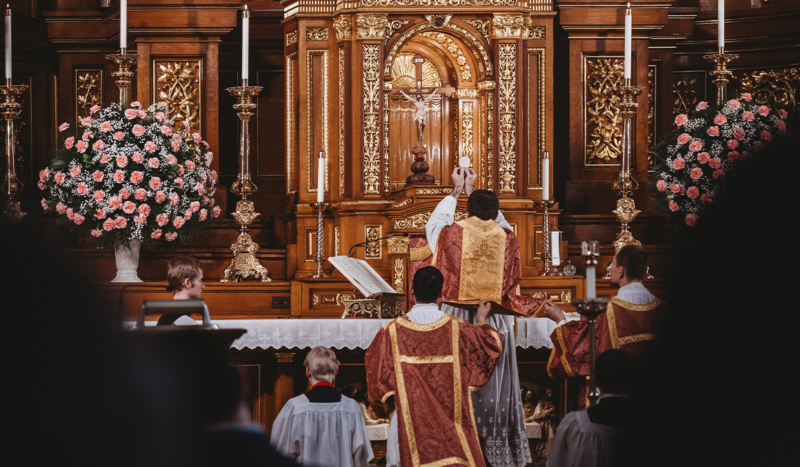
Photo by Alison Girone
In a wide-ranging June 3 essay titled “Imagine Liturgical Peace,” Catholic publisher Mark Brumley urged Church leaders to approach the question of the Traditional Latin Mass (TLM) with humility, dialogue, and pastoral generosity — warning that containment strategies risk alienating the faithful and deepening division.
Brumley, president and CEO of Ignatius Press, acknowledged that he is not personally invested in the TLM.
“For the record, my wife and I are members of a fairly middle-of-the-road Catholic parish,” he wrote, “with Mass celebrated according to the rubrics. That is, the 1969 Mass rubrics. And in English. No TLM.”
But, he added, like many Catholics, he has traditionalist friends and family and believes fostering “deeper communion should be on every Catholic’s agenda.”
Brumley’s essay, published in the What We Need Now Substack newsletter, comes amid renewed tensions over the Latin Mass. Singapore’s Cardinal William Goh recently said he hoped the Church would drop restrictions on the older form. Archbishop Salvatore Cordileone of San Francisco “seconded” the comment on X, calling such a move “grand, healing, and unifying.”
But the Diocese of Charlotte, North Carolina, took a different course, as CatholicVote previously reported. There, Bishop Michael Martin, OFM Conv., recently restricted the TLM to a single non-parish chapel in line with Pope Francis’ Traditionis Custodes and originally set to take effect July 8 — a move critics have called premature and unnecessarily harsh.
He has since postponed the plans and said the diocese would follow any changes to the 2021 motu proprio between now and Oct. 2, the original end date of the Vatican extension for four parishes in the diocese to continue offering the TLM. The initial May 23 announcement caused controversy, which intensified after a draft of major changes to the diocese’s overall liturgical norms was leaked along with the future Pope Leo reportedly telling the bishop to slow down with changes in the diocese.
Brumley expressed empathy for bishops trying to balance competing priorities but questioned the effectiveness and tone of what he described as a “containment” or “suppression” approach.
“Even many Catholics with little or no interest in the TLM may find highly ‘unpastoral’ what looks to many like a harsh ‘containment’ or ‘suppression’ strategy,” he wrote.
He argued that most TLM-attending Catholics are not radical or schismatic, but simply want to worship God in the older form of the Roman Rite.
“Let’s not overgeneralize,” Brumley cautioned, adding later that many traditionalists “want to be in full communion with the Church” and are open to dialogue.
Brumley acknowledged the damage caused by extreme rhetoric on all sides — including some traditionalists who have rejected Vatican II and denounced Pope Francis — but emphasized that many of these reactions stem from a sense of being marginalized.
“Something some critics neglect is how many hardliners feel provoked, or at least tempted, to adopt a more extreme position by various, recent upheavals in the Church, including what they feel have been public insults from church leaders, including Pope Francis, targeted at them,” he wrote. “Fair or not, those reactions should be considered in any genuinely pastoral response.”
Citing Pope Benedict XVI’s 2007 Summorum Pontificum, Brumley argued that the Church should be generous in accommodating liturgical preferences when possible.
“In any case,” he wrote, “if some committed Catholics are able to enter better into the true spirit of the Sacred Liturgy via the TLM, why should it bother me? No one is suppressing the Mass I attend.”
Brumley also drew attention to the presence of many young families at TLM parishes.
“Why risk adding them to the already large list of the disaffiliated?” he asked.
Suppressing their preferred form of worship, he warned, could push faithful Catholics away from the Church entirely.
He concluded with an appeal to the spirit of synodality and mutual recognition while noting that the world now has a pope who sings the Regina Caeli.
“I don’t have to agree with everything a Traditionalist Catholic thinks to see a brother or a sister there, and not ‘the other’ whose form of Catholic worship is to be suppressed.” he wrote. “We can walk together, right?”
“Some Catholics may say I’m a dreamer,” Brumley quipped, borrowing from John Lennon’s “Imagine.” “But then I’m not the only one. Maybe someday more will join us and the Church will be as one.”

